By Siyun
PolarDB-X V2.4 supports the clustered columnar index-based (CCI) query acceleration feature. It builds a mature column-oriented SQL engine on the low-cost OSS storage base to provide superior performance, higher cost-effectiveness, and query acceleration capabilities for query analysis.
CCI-based query acceleration is based on an architecture that separates storage and compute. The columnar engine builds CCIs, consumes binlogs of distributed transactions in real time, synchronizes them to CCIs, and stores them in Object Storage Service (OSS). The compute engine (CN) manages CCI-based queries and transactions. For a CCI-based query, the CN needs to pull the corresponding data from the remote OSS storage for MPP (Massively Parallel Processing) calculation.
While benefiting from the convenience and scalability provided by the compute-storage separation architecture, we are also facing new challenges, one of which is the transaction consistency and compatibility of queries. To address this, extensive work has been done to ensure the consistency, freshness, and compatibility of CCI-based queries.
Before introducing the principle of column-oriented consistent snapshot reading, we need to learn about the CCI storage model.
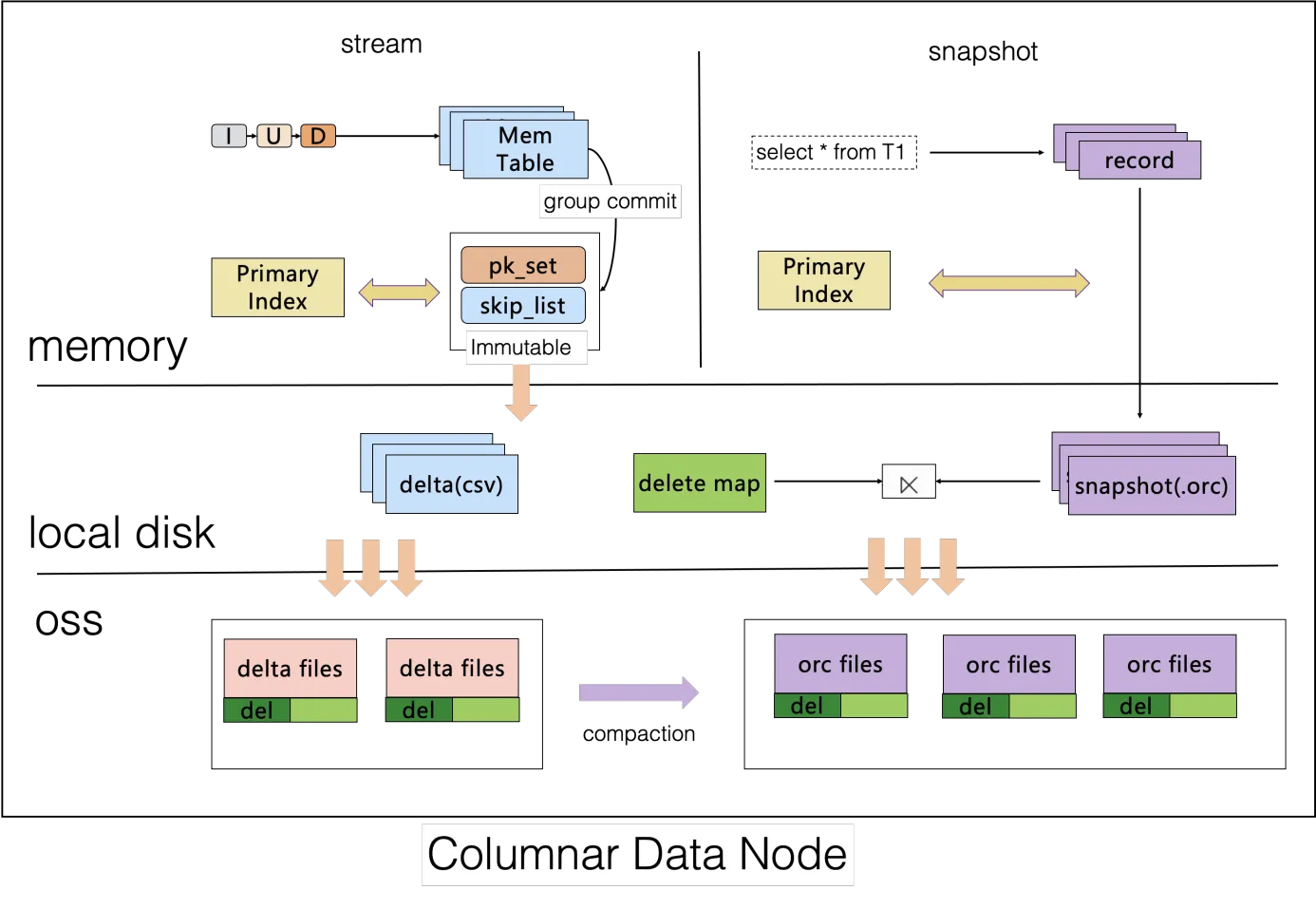
PolarDB-X CCIs are stored in the Delta + Main + Delete-and-Insert structure. Data constructed is stored in OSS in the format of CSV + ORC + Delete bitmap.
CSV and Delete bitmap support appending writing. The Update operation of incremental data is split into Insert and Delete operations. In each group commit cycle, the Insert data is appended to the end of the CSV file. The Delete operation locates the deleted data based on the primary key index, generates a bitmap, and appends it to the end of the Delete bitmap. When the incremental data exceeds a threshold, the columnar engine asynchronously performs compaction to convert incremental files into query-friendly ORC files.
Compared with Copy-on-Write and Merge-on-Read approaches, this model realizes low-latency synchronization of row-oriented data to column-oriented data and does not introduce excessive additional overhead on the query side.
For more information about how to create a CCI, please refer to A New Feature of PolarDB-X HTAP: Clustered Columnar Index
In each group commit, append write and compaction of the columnar engine indicates that a new version of a column-store snapshot is visible to the public. Each snapshot is uniquely identified by a Timestamp Oracle (TSO). Each time a column-store snapshot is generated, the columnar engine writes information about this snapshot to GMS, including TSO, the location and length of appended files, and files deleted and added during compaction. These column-store snapshots logically constitute a CCI version chain, as shown in the following figure.
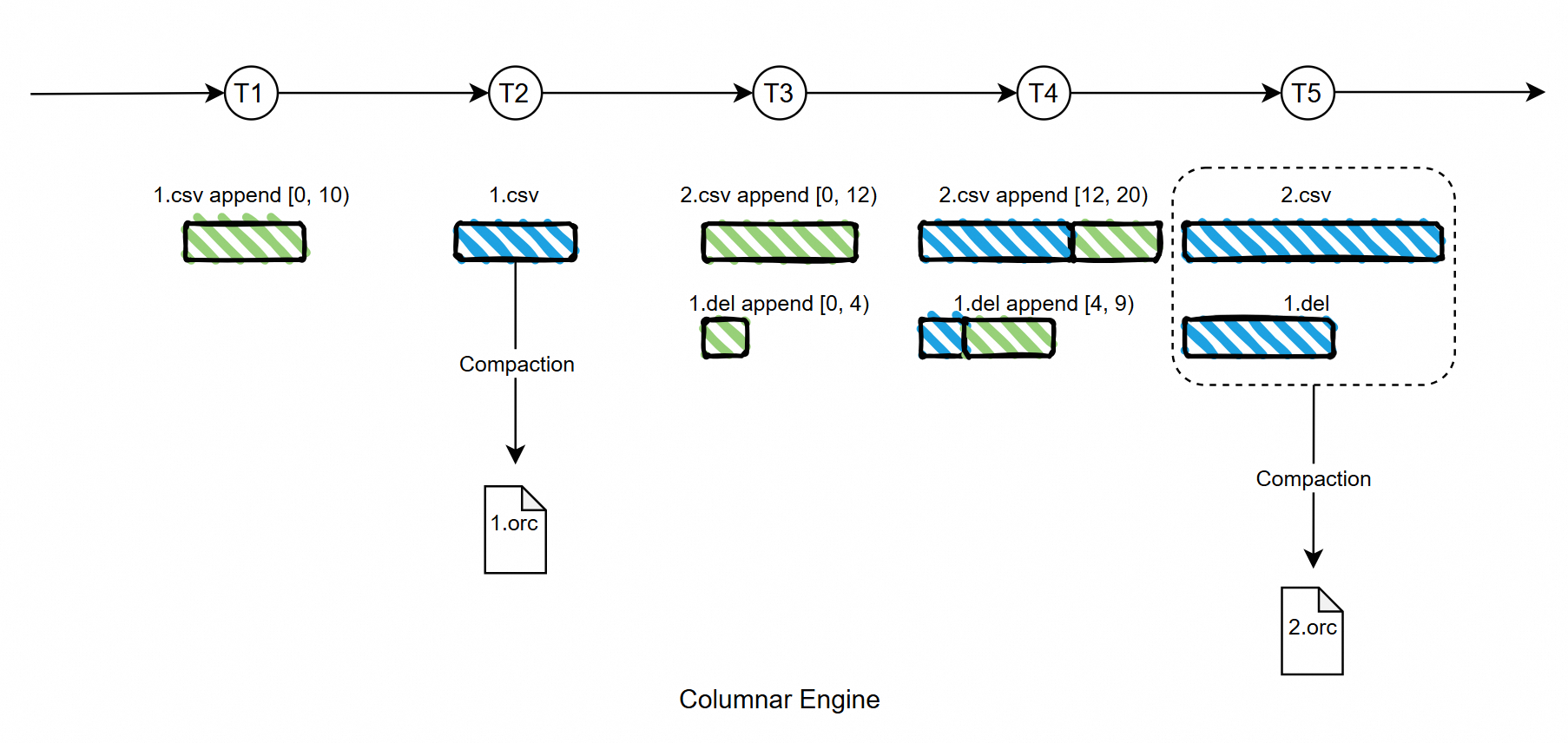
PolarDB-X CCI-based queries also need to consider multi-version concurrency control (MVCC). Different from row-oriented storage, CCI write requests come from the internal columnar node and only read requests are directly from the user. As a result, it can be simplified into the following model.

The group commit and compaction of the columnar engine continuously extend the version chain through the two-phase commit protocol. In the preparation phase, a new version is applied on the version chain. After incremental data is written to OSS, the commit operation is performed to make this node on the version chain visible externally. In addition, to prevent the version chain from being extended indefinitely, the columnar engine also performs the purge operation to clean up excessively old versions, thereby freeing up space in GMS and OSS.
The columnar query engine needs to provide concurrent query capabilities externally. The leader CN in the MPP cluster actively detects the new version in the version chain and broadcasts it to other CNs, so that the column-store snapshots of the version can be queried regardless of which CN receives traffic. Each CCI-based query from the user is randomly routed to a CN. Then, the CN acts as the coordinator of MPP queries to find the latest column storage version in the version chain and build a column-store ReadView. A column-store ReadView contains the TSO, the list of visible files corresponding to the version, and the visible offset of the incremental file. Then, the coordinator constructs a column-oriented scan operator based on ReadView, and sends the scan tasks of these files to all compute nodes (Worker) according to certain rules. Based on the scheduling rules by file hash and partition hash, we guarantee the local cache affinity of each compute node. This feature will be described in the next chapter.
To prevent query failures caused by snapshots being cleared prematurely, the leader CN regularly collects all column-store ReadViews that are active on the CN, obtains the low watermark of the active column storage transactions, and notifies the columnar engine that only versions below this watermark can be purged.
Based on the CCI version chain, we also provide the capability of consistent row-column hybrid snapshot. Due to the group commit mechanism, one append write of the column storage corresponds to multiple row storage transactions. Therefore, in hybrid row-column queries, to ensure the consistency of row-store and column-store snapshots, we use the latest TSO of the column-store snapshot and leverage the MVCC mechanism of the row storage's InnoDB to read snapshots on the row storage.
Different from the compute-storage integration system that uses the write cache to query incremental data in place, PolarDB-X compute nodes still need to pull data from remote OSS when querying incremental data. This requires a more refined design of the cache system to reduce the latency of CCI queries and improve user experience. To optimize the construction efficiency and query efficiency of column-oriented consistent snapshots, we introduce affinity caching and adopt various optimization methods to accelerate the construction of snapshots and the query of incremental data.
The local cache of the columnar query engine adopts a multi-level cache using both memory and local disks, including:
For an MPP column-oriented query, the coordinator constructs file tasks to be scanned by each scan operator based on the column-store ReadView. To maximize the use of the local cache of each compute node and minimize the cache miss probability, we need to ensure the node affinity of the cache. In other words, for all CCI-based queries, scan tasks of the same file are scheduled to the same compute node as much as possible.
In addition, for incremental data, we designed a multi-version data cache structure based on its characteristics to reduce the read overhead of incremental data. The overall cache design is shown in the following figure.
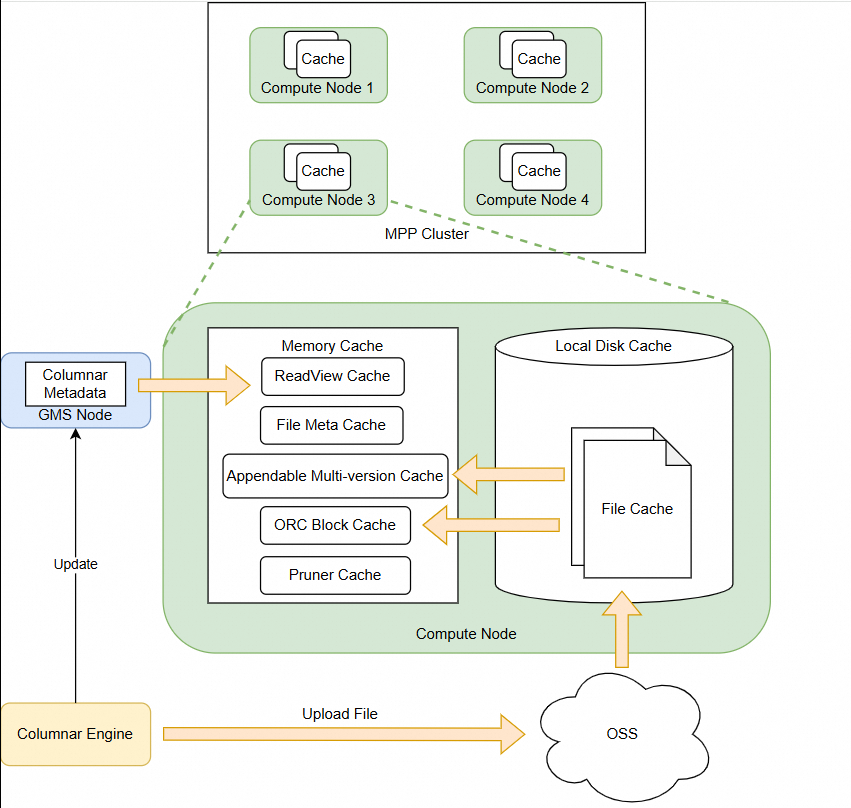
When scheduling scan tasks, we introduce two scheduling algorithms for different scenarios:
The scheduling logic of any scan operator for an MPP query must match one of the two algorithms. It can be concluded that if the cache space is large enough, any piece of data will only generate cache misses twice at most. Thanks to this scheduling mechanism, PolarDB-X CCI-based queries can adaptively adjust the scheduling logic in the face of different loads, while ensuring a certain degree of cache node affinity.
To ensure write performance and query freshness, incremental data uses a CSV file that can append write. Due to its row storage feature, the query performance of CSV is naturally inferior to ORC. On the other hand, CSV files reflect the most recently written incremental data, and their query performance directly affects the user experience with CCI-based queries. If a bottleneck occurs when reading incremental files, the user side will reflect a jitter in query performance when data is written. To this end, we reuse data as much as possible in the design of the CSV cache and trade space for time. We convert the CSV stored by row into the chunk cache stored by column on the compute node to reduce the cost of incremental data reading.
Given the append write feature of CSV, consider a scenario where the CSV file at snapshot T0 contains 2,700 rows, and an additional 300 rows are appended at snapshot T1 and another 200 rows are appended at snapshot T2. Then, for queries of T2 and T3, the cache of the first 2,700 rows of data and the first 3,000 rows can be reused. Therefore, we adopt a segmented multi-version cache approach to reuse the cache as much as possible. The overall design is shown in the following figure.
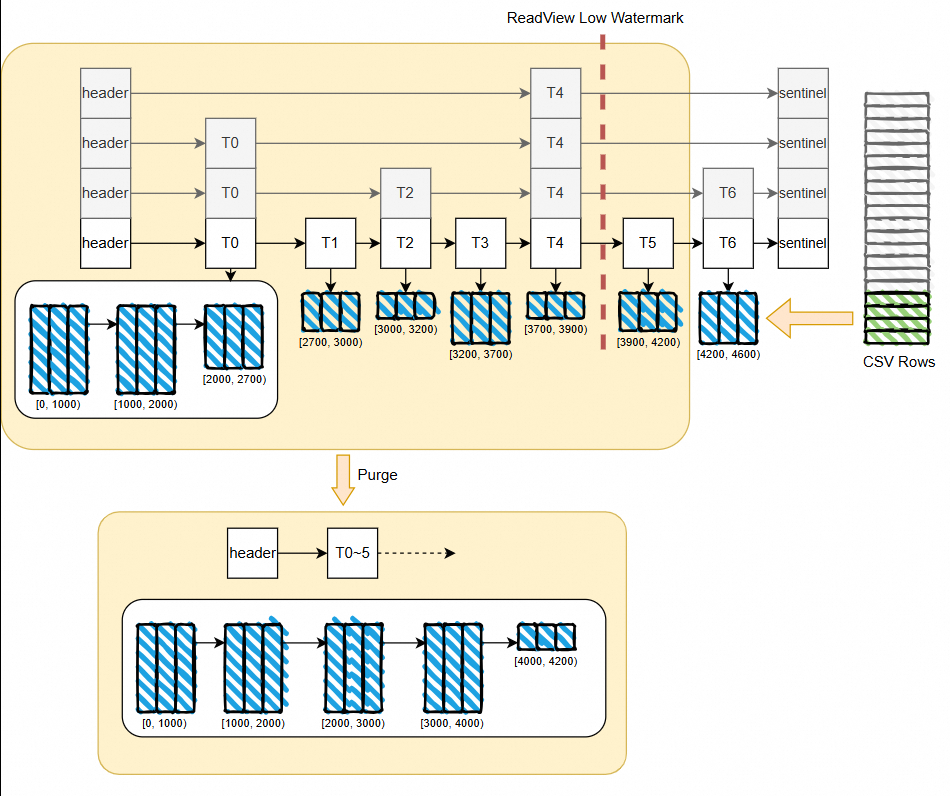
The CSV cache uses a skip list to maintain multiple versions of the cache node. On the leaf node, it points to all chunks appended to the corresponding version. In the query engine, data and intermediate results are stored in the form of chunks. By default, each chunk contains 1,000 rows of data, organized by columns in memory. The CSV cache directly retains chunks, allowing the executor to use the cached data without the overhead of converting CSV rows to columns. Based on the cache structure in the preceding figure, we mainly introduce the processing logic of the following three processes: query, load a new version, and cache purge.
For a delete operation, the columnar engine uses the primary key index to find all the delete positions corresponding to this batch of delete operations, that is, the row number in which file is deleted, and generates a bitmap after aggregation by file. We choose RoaringBitmap as the storage structure, which has a high compression ratio and good performance in our benchmark test. After the corresponding RoaringBitmap is generated, the columnar engine serializes it and appends it to the Delete Bitmap file in a fixed format for the query engine to pull. Similar to CSV, the cache of Delete bitmap also adopts a multi-version design. The overall design is shown in the following figure.
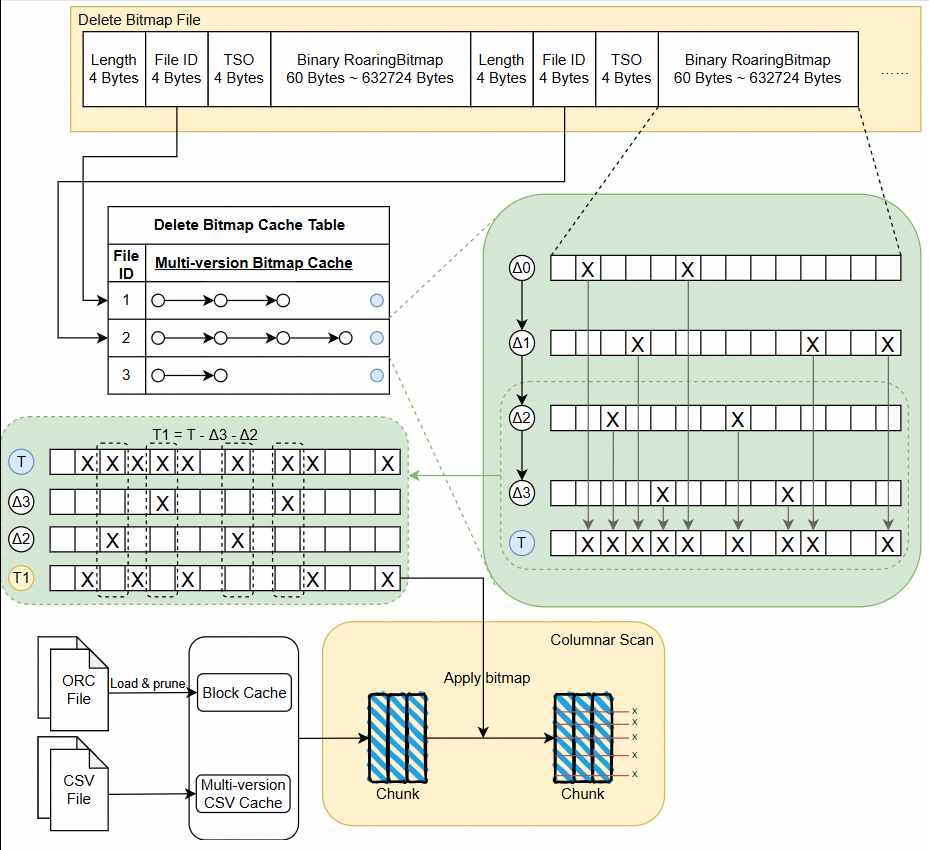
For the multi-version cache of Delete bitmaps, similar to CSV cache, we first load and parse the RoaringBitmap appended and deleted by each version, as well as its corresponding file (File ID) and version (TSO), and organize them in the form of linked lists or skip lists in memory. However, when generating a Bitmap of a certain version, we do not merge all incremental Bitmaps before the version, but first maintain the latest Bitmap T in memory, and then subtract (logical XOR) the Bitmaps of these versions that differ from the latest version. Since users generally query data of newer versions, this optimization is evident when the version chain is long.
When performing CCI-based queries, we need to merge the ORC or CSV data with the Delete bitmap and delete the corresponding rows to obtain the correct snapshot data. As shown in the figure, when we need the snapshot of the file with File ID 2 at time T1, we subtract Δ3 and Δ2 from Bitmap T to obtain the T1 version of the Bitmap, and then apply it to the chunk to generate the snapshot at time T1.
For these caches, we incorporate a unified memory management mechanism to prevent excessive memory-consuming large queries and some resident caches from dragging down the overall performance. When the memory is insufficient, the compute node triggers a spill to store the cache on the disk and release the memory.
The cache of the columnar query engine optimizes for performance by trading space for time, reducing the cost of pulling data from remote storage and accelerating the generation and query of column-store snapshots. However, when new data is written, and users query this new version of data, a cache miss is bound to occur because this version of data has not been loaded in the cache. Therefore, new data can only be pulled from remote OSS. This problem causes performance jitters in CCI queries. Whenever new data is written, the query on the corresponding CCI will be stuck due to cache miss, which greatly affects user experience. Therefore, we introduce a data preheating mechanism to actively pull metadata and incremental data from OSS to the local disk and memory cache of compute nodes.
When processing incremental data, to reduce the number of network I/O and improve the upload efficiency, the columnar engine first batches the data to the local disk, and then uploads it to the remote OSS. Therefore, for relatively new incremental data, in addition to persisting it in OSS, the columnar engine also retains a cache on the local disk. Appendable objects in OSS have a higher latency than normal objects when pulling newly written content for the first time. To accelerate incremental data queries, we introduce a bypass loading mechanism. When a compute node pulls the data that exists in the local disk of the columnar engine, the compute node directly requests the data through the internal network instead of from OSS, as indicated by the red dashed line in the diagram below.
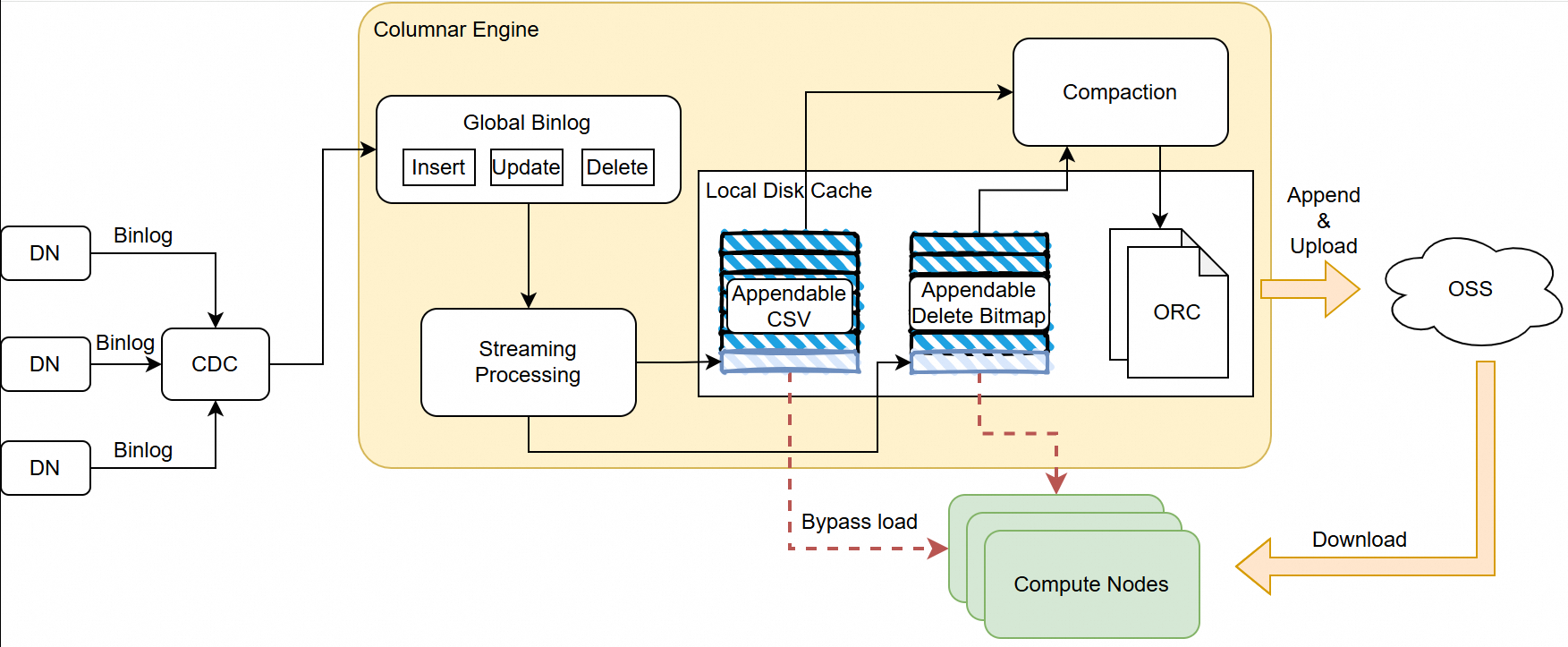
Based on the column-store version chain and efficient column-store snapshot generation technology, we can implement flashback queries on CCIs. By default, users can only query data within the most recent period, specifically snapshots that have not been cleaned up by the columnar engine. For users who require flashback queries, they can enable the column-store snapshot saving feature to manually or automatically save column-store snapshots at a specified point in time so that the snapshots of this version are not deleted. During a flashback query, users can specify the time or TSO. The columnar query engine will find the version closest to the specified time on the version chain and build a column-store snapshot for queries. For the reason that flashback queries are different from regular business traffic and do not have temporal locality, the columnar query engine bypasses the cache on the main link during flashback queries and directly pulls data from remote storage for queries to avoid cache pollution. This feature will be described in detail in subsequent articles. Please stay tuned.
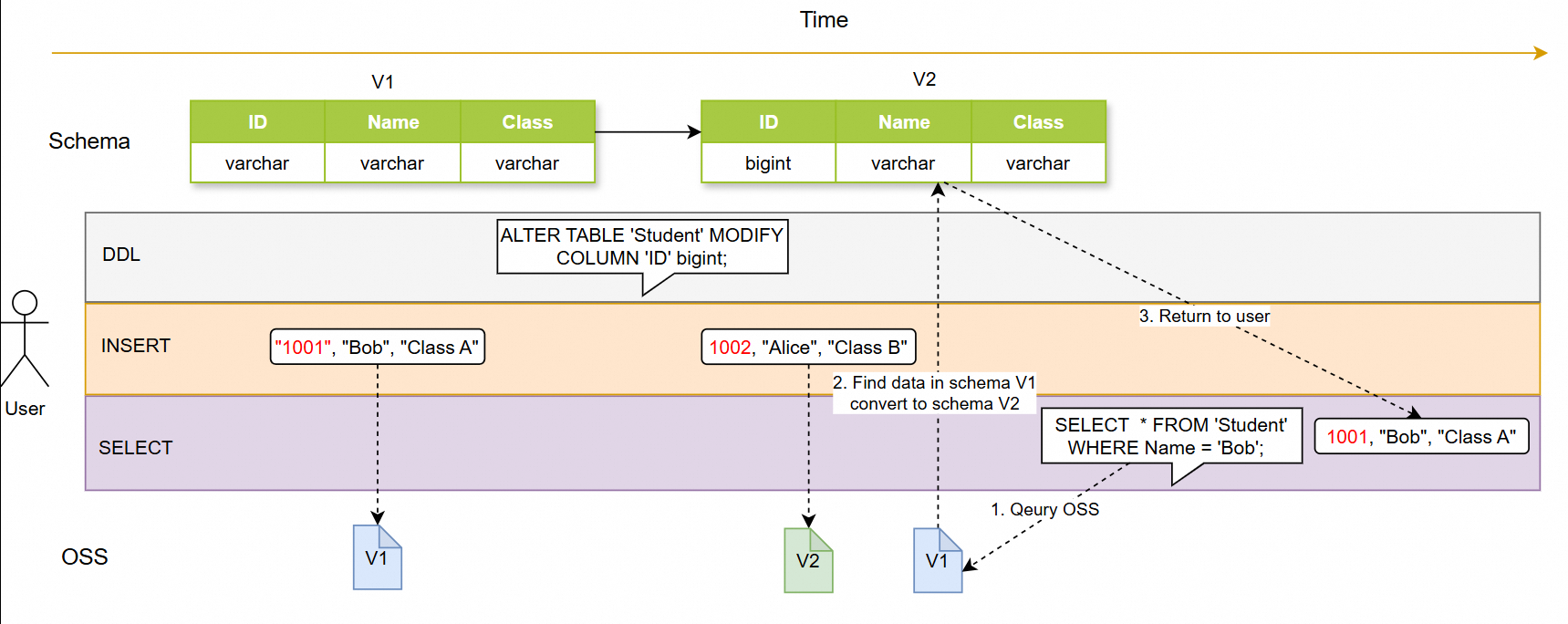
PolarDB-X CCIs support multiple versions of schemas. For more information, please refer to Full Support of PolarDB-X Columnar Index for Multi Schema.
When performing DDL (Data Definition Language) operations, CCIs use multiple versions of schemas to maintain a new version of the schema instead of immediately converting and integrating the data types of physical files. The newly written data is stored in the format of the new schema. In the query engine, we maintain the mapping relationship between multi-version schemas and specific ORC and CSV files. During the query, if the latest version of data is scanned, the returned results are directly parsed. If the old version of data is scanned, column mapping, data type conversion, and default value filling are performed when parsing the data. Based on this mechanism, we can provide the schema traversal capability in the future, that is, restore the schema at a specified time, or query data based on the schema at a specified time.
DDL is a common practice in databases. Frequent DDL operations are inevitable for many fast-iterated business systems. Based on the preceding asynchronous DDL solution, it is obvious that the cost of CCI-based queries is positively correlated with the number of DDL operations. In particular, when you repeatedly modify the column type of the same column, the data of the earliest version needs to be converted in multiple steps, which is unacceptable. Therefore, the compaction task of the column storage also converts the data type of the old version, converting all old version schemas to the latest version. This ensures that the snapshots of the same version do not contain multiple versions of the schema, reducing the overhead of subsequent CCI-based queries.
Based on the MySQL ecosystem, PolarDB-X CCI-based queries provide the same type compatibility as row-oriented queries. For CSV files, we adopt a storage format compatible with MySQL-native Binlog Write_rows_log_event and parse them during queries. For ORC files, since the native ORC format is not directly compatible with the MySQL type system, we have carried out massive modifications and optimizations, especially for types such as decimal, timestamp, and string. This improves the compression ratio and ensures compatibility with MySQL types.
After DDL occurs, the column-oriented query engine needs to convert types during queries. To ensure the same MySQL compatibility as row-oriented queries, we adhere to the MySQL logic and properly handle issues such as numerical precision and data truncation.
PolarDB-X In-memory Column Index | Birth of the Columnar Engine
PolarDB-X Clustered Columnar Index | Secrets for Efficient DML Updates (PkIndex)
ApsaraDB - March 26, 2025
ApsaraDB - April 10, 2024
ApsaraDB - June 19, 2024
ApsaraDB - March 26, 2025
ApsaraDB - October 16, 2024
ApsaraDB - January 17, 2025
 PolarDB for Xscale
PolarDB for Xscale
Alibaba Cloud PolarDB for Xscale (PolarDB-X) is a cloud-native high-performance distributed database service independently developed by Alibaba Cloud.
Learn More PolarDB for PostgreSQL
PolarDB for PostgreSQL
Alibaba Cloud PolarDB for PostgreSQL is an in-house relational database service 100% compatible with PostgreSQL and highly compatible with the Oracle syntax.
Learn More PolarDB for MySQL
PolarDB for MySQL
Alibaba Cloud PolarDB for MySQL is a cloud-native relational database service 100% compatible with MySQL.
Learn More Database for FinTech Solution
Database for FinTech Solution
Leverage cloud-native database solutions dedicated for FinTech.
Learn MoreMore Posts by ApsaraDB
Start building with 50+ products and up to 12 months usage for Elastic Compute Service
Get Started for Free Get Started for Free